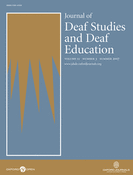-
PDF
- Split View
-
Views
-
Cite
Cite
Marc Marschark, Sue Archbold, Marian Grimes, Gerard O'Donoghue, On Language, Education, and Cochlear Implants, The Journal of Deaf Studies and Deaf Education, Volume 12, Issue 3, Summer 2007, Page 257, https://doi.org/10.1093/deafed/enm025
Close - Share Icon Share
In closing a keynote presentation at a recent international conference on deaf education, the speaker noted that “There has never been a better time to be a deaf child … or a parent or educator of one.” That suggestion is consistent with our intuitions and reflects significant strides that have been made recently in a variety of domains relevant to the development and education of deaf children. Investigations into language acquisition, the foundations of literacy, new educational methods, family- and child-oriented support services, and the cognitive underpinnings of learning are all helping to increase the opportunities and achievements of students who have significant hearing losses. There also have been major technological developments including newborn hearing screening and diagnostics, digital hearing aids and cochlear implants, and instructional technologies.
Two recent international conferences have examined ways in which this progress is influencing our understanding of deaf learners and how it will change the face of deaf education in the coming years. “Language and Deaf Education: Into the 21st Century” was held in Dunblane, Scotland, in celebration of the life and work of Mary Brennan, who died in 2005 (see Journal of Deaf Studies and Deaf Education [JDSDE], Volume 11, No. 1). That meeting explored interventions that can maximize language and communication development (both signed and spoken) as well as educational success for deaf children. The “Cochlear Implants: Educational Implications Conference,” held in Nottingham, England, focused on the broad implications of cochlear implants for school-aged children.
Volume 12, Nos. 2–4, of the JDSDE contain papers written by presenters at these conferences and other authors, charting some of the future directions made possible by recent discoveries and innovations. The meetings sought to evaluate the current state of knowledge in these areas and allied fields with the hope of bridging research and practice and optimizing future achievement in the lifelong learning of children with significant hearing losses. More generally, investigations of the sort presented in these three issues offer exciting new insights into the strengths and needs of deaf children while developing tools and methods for ensuring that they have full access to academic, social, and employment opportunities. As coeditors of this series, we hope that these collected articles will help to engender new discussions and perspectives that further advance the frontiers of learning and academic success for all deaf children.
In order to facilitate broad participation of the various stakeholders and deaf education, Oxford University Press also will create two electronic special issues of the JDSDE to be available at http://www.jdsde.oxfordjournals.org/. One of the issues will be on cochlear implants in the development and education of deaf children; the other will describe recent progress in understanding and enhancing the links among language, literacy, and education, an area of investigation that owes much to the pioneering work of Mary Brennan. We hope that these collections will extend the impact of the research described here and by other investigators to explore the applied potential of basic research and develop research methods to validate and extend current educational practices


